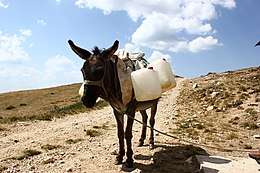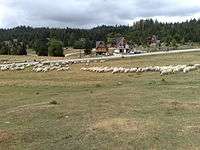Vlašić cheese
Vlašić cheese or Travnik cheese (Vlašić's cheese = Serbo-Croatian: Vlašićki sir / Travnik's cheese = Serbo-Croatian: Travnički sir) is brined mostly low-fat white cheese made of sheep-milk. Cheese originating from the mountain of Vlašić, just above the town of Travnik in central Bosnia and Herzegovina. Depending of amount of brine (salty water) cheese is kept in, its texture and taste can vary but is mostly dry and quite salty.[1][2]
| Vlašić cheese | |
|---|---|
 | |
| Country of origin | Bosnia and Herzegovina |
| Region | Central Bosnia |
| Town | Travnik |
| Source of milk | Sheep's, also cow's and mixtures |
| Pasteurised | No |
| Texture | white, medium hard |
| Fat content | low |
| Dimensions | not defined |
| Aging time | 60 to 90 days |

History
The toponym Vlašić (mountain name) derived from the name Vlasi (Serbo-Croatian for Vlachs), historically used in Bosnia and Herzegovina for its transhumant population. Academics like late Marko Vego believe that the Vlachs, as remnant of the Roman Empire, came up with a recipe for the trademarks of product of the mountain and the region, namely the Vlašić cheese, sometime around 1000 AD or earlier. Henceforth, by perfecting the recipe, the Vlachs passed on the tradition to other cattle breeders from the surrounding mountains.[2]
Production and characteristic
Vlašić cheese is a white cheese that matures in brine. It is originally made from fresh sheep milk, but of recently also cow milk is used, or a mix of both varieties, and then left to ripen for two to three months.
Cheese is brined and mostly low-fat. It's a white in color, and can either have small irregular holes scattered in it, or be solid without holes. Depending of amount of brine (salty water) cheese is kept in its texture and taste can vary, but drained it turns mostly dry and quite salty in taste. The milk has a special flavor that comes from the variety of different herbs that sheep are eating while grazing on Vlašić and the surrounding mountain.[2]
Popularity and consumption
Today, the cheese is produced throughout Bosnia and Herzegovina, but is regarded as particular traditions of the region of Central Bosnia, Vlašić mountain and town of Travnik. In addition to the cheese, two other particular trademarks of the region exist, the Tornjak dog and Pramenka sheep.[3] The Tornjak is believed to have existed for more than a millennia, bred to guard people and its livestock from wolves and bears. Its etymology is connected to Neo-Latin torni acca ("turn here").
The Vlašić cheese was awarded many prizes over the years, with gold medal won at 12th International Exhibition of Cheese in Austria (Die internationale Käsiade) in 2014 among most recent ones.[4]
 Sheep on Vlašić
Sheep on Vlašić Sheep on Vlašić
Sheep on Vlašić
References
- "Cheese from Vlašić" (pdf). farmabih.ba. The Association of cheese producers in Bosnia and Herzegovina. Retrieved 6 April 2019.
- "Vlašic Cheese - Arca del Gusto" (html). Slow Food Foundation. Retrieved 6 April 2019.
- "Pramenka Sheep - Arca del Gusto" (html). Slow Food Foundation. Retrieved 6 April 2019.
- "12th International Exhibition of Cheese in Austria: Three Gold Medals for BIH!". Sarajevo Times. 11 November 2014. Retrieved 6 April 2019.